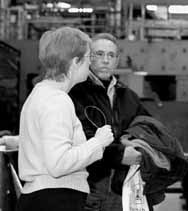 |
|
New View of NuMI by Kurt Riesselmann It was close to midnight. Batavia resident Iris Ware was thinking of going to bed when a sound like a thunderclap broke the silence, rattling the windows of her house. A few moments later, everything was quiet again. What was that? Suspecting that construction activity at neighboring Fermilab might have been responsible and worried about possible damage to the foundation of her house, Ware called Fermilab to get some answers about what was making her windows rattle.
Since March 2000, the S.A. Healy Company of Lombard, Illinois, has been carving out an underground system of halls, shafts and tunnels for the Neutrinos at the Main Injector project. Because most of the construction takes place in the dolomite and shale rock beneath the Fermilab site, blasting became the excavation method of choice. So far, S.A. Healy has carried out more than 200 blasts at Fermilab. The NuMI construction is the first step in building an experiment that will determine whether neutrinos, ghost-like particles zipping through our universe at or near the speed of light, have mass.
"We know you hear noise," said Laughton. "But the blasting will not harm nearby structures, either in the neighborhood or at the laboratory itself. We carefully monitor the noise and vibration levels."
Dane Tittman knows vibration. Tittman, area manager of the Vibra-Tech company, also explained to neighbors how windows can rattle even when the ground doesn't move. "The rattling windows are due to air overpressure escaping the tunnels through the shafts," he said. "There is no danger of foundations cracking." Though neighbors often perceive the rattling windows as a sign of ground motion, Tittman reassured them that this is not the case. "Our measurements here at Fermilab and in the neighborhood confirm that there are no significant ground vibrations," he told the neighbors. "Ground vibrations travel about 12 to 18 times faster than sound. You would feel them about three to four seconds before the sound." Like powerful loudspeakers that produce pressure waves and make objects vibrate, the excavation blasts create short, strong pressure waves that travel through air. Depending on the strength of the blast and weather conditions, these pressure waves can travel into nearby residential areas. Tittman showed plots of sound and ground vibration measurements made at Fermilab and at houses in the neighborhood. He compared the results with the limits recommended by the U.S Bureau of Mines to avoid structural damages to residential buildings. "Many studies have looked at the impact of blasting on residential structures," Tittman explained. "They studied various types of houses and looked at the effect of blasting on foundations, dry wall, plaster and so forth." To demonstrate the sensitivity of his monitoring equipment, Tittman showed a plot of the vibration generated by a dog walking around the instruments in a neighbor's back yard. "Different sources of vibration cause different patterns in the signals," he explained. "Looking at these particular waveforms, I immediately knew they didn't come from blasting." Ken Bailey, a Fermilab neighbor living near Pine Street, asked Tittman about the impact of the vibrations on water wells. "Water wells are not affected unless ground vibration intensities exceed speeds of two inches per second peak particle velocity," Tittman said. "The vibrations recorded at Fermilab and in the neighborhood are well below this limit." As neighbors talked to Fermilab scientists, they also had an introduction to neutrinos and the Main Injector Neutrino Oscillation Search experiment that will be built once the NuMI construction is finished. The experiment will measure whether neutrinos change their identity as they travel through space and matter. "I come to Fermilab for biking and fishing," one neighbor said. "It's fascinating to find out about the neutrino research that's happening here." Fortunately, unlike the construction for the neutrino experiment, the neutrinos themselves won't make a sound. For more information see: |
| last modified 2/2/2001 email Fermilab |
FRLsDFx9eyfrPXgV
 Ware wasn't the only local resident who wondered what was up. On January 16, Fermilab neighbors, who, like Ware, had questions about loud noises from their normally quiet neighbor, had a chance to find out exactly "What was that?" About 60 local residents attended a "Just for Neighbors" Open House at Fermilab, where they heard from managers and construction experts about the NuMI project and its effects on the neighborhood.
Ware wasn't the only local resident who wondered what was up. On January 16, Fermilab neighbors, who, like Ware, had questions about loud noises from their normally quiet neighbor, had a chance to find out exactly "What was that?" About 60 local residents attended a "Just for Neighbors" Open House at Fermilab, where they heard from managers and construction experts about the NuMI project and its effects on the neighborhood.
 At the Open House, neighbors heard from physicist Dixon Bogert, NuMI project manager, and mining expert Chris Laughton, NuMI construction manager. They gave the bad news: It's loud. And they gave the good news: It won't harm your house, drain your well, or crack your foundation.
At the Open House, neighbors heard from physicist Dixon Bogert, NuMI project manager, and mining expert Chris Laughton, NuMI construction manager. They gave the bad news: It's loud. And they gave the good news: It won't harm your house, drain your well, or crack your foundation.
